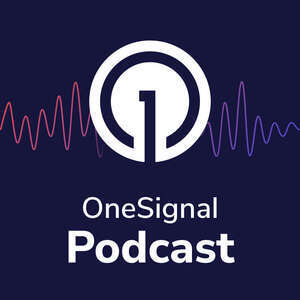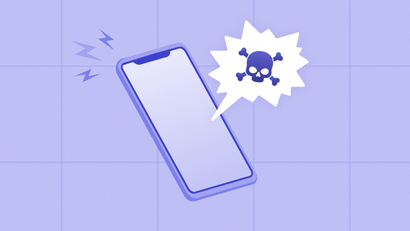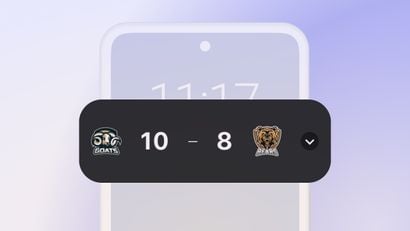
The term “app notification app icon badge” may seem like a mouthful, but the concept in itself is fundamentally simple. In this piece, we’ll unpack just what these little pieces of the app experience actually do and how they play into your messaging strategy.
What’s an app icon and why is it important?
Before we get into what an app icon notification badge is and how it works, it’s helpful to understand how app icons themselves are important to the user experience. According to Apple developer resources, an app icon is..
“A unique, memorable icon [that] communicates the purpose and personality of your experience and can help people recognize your app or game at a glance in the App Store and on their devices.”
Your app icon is important in the processes of app discovery, branding, and recognition. These little symbols should provide a tiny but accurate and eyecatching representation of your brand.
What is an app notification icon badge?
App icon badges are a popular mobile device feature. Many app teams decide to add a numerical or visual badge to their app icon in order to inform users of updated content or messages. The main functionality app icon badges provide to the end user is to remind them unboltrustively that they have a certain number of messages that are unread or events that have occurred within the app.
Supported by Apple and Android, app notification icon badges are an important part of the web and mobile push experiences. They are critical tools for engagement in that they are intended to help illicit a response from your target users.
Anatomy of an App notification icon badge
Okay, so beyond your regular app icon, an app notification icon badge is a series of small dots that appear on the corner of the app icon to show that there s a new message pending for you within an application.
The number of red dots appearing in the corner of the red circle you see are considered the “badge count,” and this number indicates how many outstanding messages a given user has.
How do they work?
App notification icon badges appear in conjunction with your Mobile app for a handful of purposes.
The events for which they appear will depend on the nature of your app, but here are a few examples.
Flagging unread push notifications
One key use case of these badges is to flag unread push notifications. App notification icon badges provide an additional nudge on top of the initial push message that can remind users to interact with your app. You may implement a “badging” strategy in which as push notifications accumulate, so too does an app’s badge count. In this use case, when a user taps and holds a mobile app icon badge they will see a list of pending notifications appear. They can then choose to tap the notifications and be directed back into the app or they can dismiss the notifications instead.
Showcasing New Emails
It’s important to note that although push notifications are a common use case for app icon badges, notification badges can also be configured in response to events that occur within your app, such as an email being received.
This is a creative way for you to draw attention to messaging you’re sending across channels. For an email application, for instance, you can use badges to draw mobile-first email users back to their inbox.
Indicating Reception of In-App Messages
App icon notification badges can also be set up in response to a user receiving an in-app message. In all three cases, app icon badges can help increase engagement with your messaging campaigns.
Android vs. iOS
With Android 8.0, or API level 26, app notification badges show on an app launcher icon, similar to how they appear on iOS apps. With this OS, app badge dots appear by default in launcher apps that support them. As we’ve described, users can long press on the dots in order to see the full list of notifications. On Android, app notification badges can only be incremented automatically using notification categories. However, On iOS, the customer can set them to increment by a specific number.
Why do app notification icon badges matter?
Notifications app icon badges can provide an additional incentive for re-engagement without creating irritation. They can compel your user to reopen your app by creating the feeling that a user is missing out on activity within your app, or that something exciting is waiting for them in your app experience.
Badge Count can not only be used to reengage users who haven’t yet clicked on a push notification, but also to reach users who have their foreground notifications disabled. Your users are already swimming in stimulation, which is an established fact based on the following mobile app statistics.
- Users of smartphones receive 47 push per day
- Every year, Users are spending more time on their phones in 2020-2021, according to mobile marketing report
- Phone time is increasing, and the number of apps in your vertical is likely growing, which makes it ever more important to grab users’ attention in the right way.
With users inundated every day with push notifications, emails, and a variety of other stimuli in their digital environment, it’s important to take a subtle and strategic approach to alerting users to your app activity. Badges can be helpful in achieving this.
App badges commonly implemented in use cases such as the following.
1) Social or Professional Networking Apps
App notification badges can signal that a user has a pending or successful connection with another user. This can be useful for creating positive reinforcement and giving users a dopamine hit when they make new social connections.
2) Email Inbox Apps
Are you the type of email user with a 50000 badge count unread, or 3 badge count? Apps that function as an inbox or that offer an inbox element can use app icon badges to flag unread messages. For instance, if you’re a Telehealth app looking to get patients’ attention when they receive a message from a provider on your platform, it may be useful to implement app icon badge notifications to alert users to take the next step in their patient journey by replying.
3)Gaming
For gaming apps, app icon notification badges can motivate users to participate in the app experience by prompting them to take their next action. This way, users know it’s time to reengage and take another pass at the level they failed.
4) Social Apps
Think about when you’re browsing your phone and you see an app notification badges appearing on your Instagram, or Snapchat apps. In both of these cases, seeing the badge count increase not only validates you, but also entices you to click back into these platforms for an anticipated reward. App badges are yet another dopamine hit to a user’s reward system and can motivate social app users to see who liked their photo, who sent them a creative snap, or what player messaged them back on their favorite multiplayer gaming app.
When to Disable App Notifications
There are cases, however, for which users may want to disable notification icon badges. Some common reasons users may choose to disable app icon notification badges include in the case of ongoing notifications and recurring notifications for a calendar app, for instance. Seeing notifications stack up if you have no intention of tending to them can create a poor user experience and actually create anxiety around the use of a given app.
That’s why both operating systems provide ways to disable or customize notification badges in order to create a more ideal user experience. Users who see badge counts skyrocket into the double digits will be further deterred from reengaging, which is not ideal for your customer engagement strategy.
Let’s say you are in fact a Telehealth app. You won’t want to configure app notification icon badges for every single alert within your app, because doing so might create more anxiety for your users. In this case, you may decide to configure badges only for your patient-provider messaging feature, and reserve other reengagement tactics for less pressing reminders, such as a promotional reminder that a patient’s favorite allergy meds are now on sale.
Get Started with OneSignal
OneSignal is designed to help you send messages and seamlessly manage your user communication across a variety of channels, including email, mobile push notifications, web push notifications, bulk SMS, and in-app messaging. Our platform is quick to set up and makes it easy to automate your email campaigns without doing any development work. If you don't have a OneSignal account, you can create one for free — simply sign up and see for yourself!
Get Started for Free


